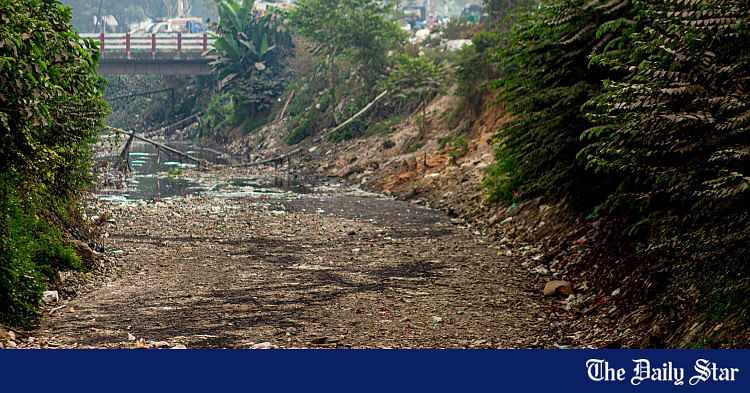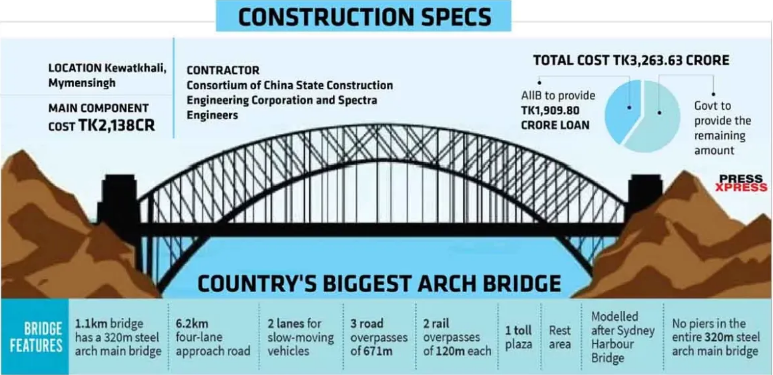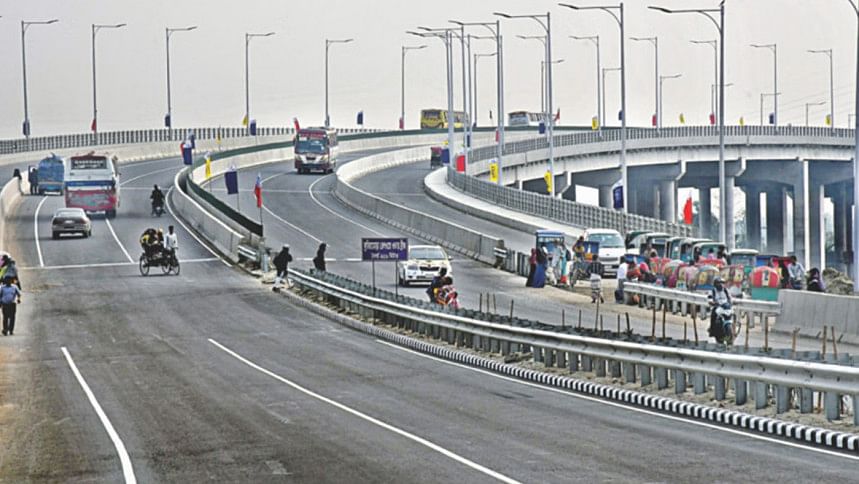Saif
Senior Member
- Messages
- 14,106
- Reaction score
- 7,446
- Origin

- Residence

- Axis Group

No further hurdles to DEE completion
FE
Published :
Oct 26, 2024 22:20
Updated :
Oct 26, 2024 22:20

The Dhaka Elevated Expressway (DEE) has had a troubled past as there had been numerous delays in completing every phase of the project. Needless to say, as it involved a steep learning curve for the government of the day and involved numerous issues ranging from land acquisition and operational problems amongst the multiple parties involved in the construction of this milestone project. Dhaka city has long been in need of an elevated expressway network as for more than a decade, traffic speeds have been crawling to single digit km per hour. Obviously, things needed to change as commerce boomed and the country needed fast track movement of cargo in and out of Dhaka city. It is with that vision in mind, DEE is being implemented.
The political turmoil notwithstanding, work on the final 25 per cent of the elevated expressway has been at a standstill since February, 2024 for reasons that are entirely legal in nature. The whole project is worth US$1.2 billion and the Thai company had been in conflict with the other two Chinese contractors that were implementing the project together. On October 20, the Singapore International Arbitration Centre (SIAC) discharged the status quo on share transfer of ITD authority to the Chinese firms and now it is hoped that work can resume without further delay. It is interesting to note that the contract had originally been awarded to Italian-Thailand Development Public Limited (ITD) way back in 2011 and now the year is 2024. This crucial project had been plodding on for more than a decade and the said company had, over the years, run short of funds and had been awarded several time extensions and cost overruns. It speaks volumes of the way infrastructure development was done in the past and things continued to get more and more complicated with the entry of two Chinese companies into the deal.
The question that comes to mind is where were Bangladeshi authorities in all this? Why weren't steps taken when things went awry in terms of getting requisite funds by contracted companies delaying project implementation that ultimately ended up costing years in delay and cost revisions upward? There appeared to be little or no compunction on the part of the concerned authorities of the previous government to expedite the process. Rather, as with most of the mega-infrastructure projects undertaken in the past decade and a half, the modus operandi had been to award contracts to foreign companies and hope for the best. That is not how development is achieved, rather that is the perfect recipe for corruption to take place - at the cost of wastage of public money and years lost in implementation. As the High Court in Bangladesh finally cleared the case on September 01, 2024, the parties concerned went for international arbitration in Singapore and a verdict had been delivered in less than two months. The fault lies with the Bangladesh Bridges Authority (BBA) in its failure to take active measures against contractors who wasted precious time and resources to complete the project.
This experience should act as a case study for future development work undertaken by the current government to avoid the pitfalls in contracts management, and penalties and exit policies need to be carefully defined in public-private partnership contracts to avoid situations like this. Every single mega-project needs to be reviewed to find out what can be done to rectify signed contracts so that the country does not suffer undue headache because of a lack of professionalism on our part.
FE
Published :
Oct 26, 2024 22:20
Updated :
Oct 26, 2024 22:20
The Dhaka Elevated Expressway (DEE) has had a troubled past as there had been numerous delays in completing every phase of the project. Needless to say, as it involved a steep learning curve for the government of the day and involved numerous issues ranging from land acquisition and operational problems amongst the multiple parties involved in the construction of this milestone project. Dhaka city has long been in need of an elevated expressway network as for more than a decade, traffic speeds have been crawling to single digit km per hour. Obviously, things needed to change as commerce boomed and the country needed fast track movement of cargo in and out of Dhaka city. It is with that vision in mind, DEE is being implemented.
The political turmoil notwithstanding, work on the final 25 per cent of the elevated expressway has been at a standstill since February, 2024 for reasons that are entirely legal in nature. The whole project is worth US$1.2 billion and the Thai company had been in conflict with the other two Chinese contractors that were implementing the project together. On October 20, the Singapore International Arbitration Centre (SIAC) discharged the status quo on share transfer of ITD authority to the Chinese firms and now it is hoped that work can resume without further delay. It is interesting to note that the contract had originally been awarded to Italian-Thailand Development Public Limited (ITD) way back in 2011 and now the year is 2024. This crucial project had been plodding on for more than a decade and the said company had, over the years, run short of funds and had been awarded several time extensions and cost overruns. It speaks volumes of the way infrastructure development was done in the past and things continued to get more and more complicated with the entry of two Chinese companies into the deal.
The question that comes to mind is where were Bangladeshi authorities in all this? Why weren't steps taken when things went awry in terms of getting requisite funds by contracted companies delaying project implementation that ultimately ended up costing years in delay and cost revisions upward? There appeared to be little or no compunction on the part of the concerned authorities of the previous government to expedite the process. Rather, as with most of the mega-infrastructure projects undertaken in the past decade and a half, the modus operandi had been to award contracts to foreign companies and hope for the best. That is not how development is achieved, rather that is the perfect recipe for corruption to take place - at the cost of wastage of public money and years lost in implementation. As the High Court in Bangladesh finally cleared the case on September 01, 2024, the parties concerned went for international arbitration in Singapore and a verdict had been delivered in less than two months. The fault lies with the Bangladesh Bridges Authority (BBA) in its failure to take active measures against contractors who wasted precious time and resources to complete the project.
This experience should act as a case study for future development work undertaken by the current government to avoid the pitfalls in contracts management, and penalties and exit policies need to be carefully defined in public-private partnership contracts to avoid situations like this. Every single mega-project needs to be reviewed to find out what can be done to rectify signed contracts so that the country does not suffer undue headache because of a lack of professionalism on our part.



